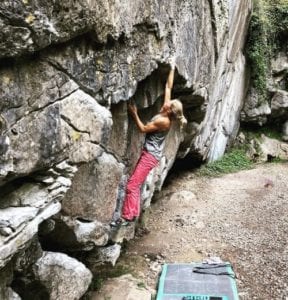Dr. Natalie Brown on Training and the Menstrual Cycle
Doctor Natalie Brown discusses the four phases of the menstrual cycle and how athletes might optimize their training around them

Dr. Natalie Brown is an expert on female athletics and the menstrual cycle. As a climber herself, Brown has developed an interest in discerning how the estrous cycle affects the climber at each of its four stages.

In February 2021, Brown joined the Ontario Climbing Federation (OCF) for a conversation regarding climbing and the menstrual cycle. Historically, sports research has a male focus that presumes women to be similar to men in their physiology. Due to processes such as the menstrual cycle, such presumptions fall short of reality and can make periodization training, or even the simple scheduling or training sessions, challenging for athletes that experience a period. Superimposing a male’s training plan onto a female climber may make that climber stronger, but it is unlikely to optimize each training session for that athlete.
In an effort to combat this issue, Brown spoke with eight elite female climbers to understand their perceptions and experiences of the menstrual cycle in relation to climbing. Using these perceptions as a base, along with Brown’s own experiences, Brown worked to provide a conversation that tackled and discussed the details of each phase of the cycle. The menstrual cycle is a normal part of life and should become a normal aspect of the training conversation.
Brown begins by discussing the length of the period. In textbooks and related materials, the menstrual cycle is described as 28 days long. This number appears palatable due to the fact that it breaks into four, perfect seven-day increments for each of the four stages that define the cycle. This number, however, is the median length of the cycle among women. According to Brown, some women experience cycles as short as 21 days or as long as 35 days. Naturally, generalization will not allow athletes the optimal training cycle, and so Brown recommends tracking your experience.

Tracking your cycle allows the climber to recognize when they feel strong or weak, and also offers the athlete the opportunity to compare performance between months. Over time, it could become clear when peak strength might occur within a cycle. It can also alleviate some of the frustration that might come across on a weak day directly before the onset of the athlete’s period. Many athletes keep a training log already. Adding this component to the log offers the athlete more information and makes progress easier to track.
Brown contextualizes the beginning of this four-part cycle as the Early Follicular Phase. This phase begins with the athlete’s period and offers some of the most imposing symptoms of the menstrual cycle. Brown reflected on this stage. “To start off, within the period, you’ve got blood loss, stomach cramps and GI (gastrointestinal) disturbance. Within the time of your period, [there] can be anxiety and distraction. Trying to do a really good training session when you’re in pain can impact performance quite a lot. There are definitely ways we can potentially manage that.
“First of all, talk. It sounds so basic, but having a conversation of what symptoms are affecting you and how it’s affecting you in training and performance can be really helpful. Every month, do you feel more agitated? Do you have cramps every month? Do you feel more bloated? How does that relate to training? Through that monitoring and self-awareness, it can help to bring up conversations that talk about how this impacts your training and performance.”

Dr. Brown continued by describing the proactive ways a person can alleviate their symptoms. “Reduce your stress levels through things like YOGA, mindfulness, [or] even things like a hot bath. Be kind to yourself. Nutrition and sleep are always super important. Those things can help alleviate symptoms and reduce the severity of them.”
Furthermore, Brown found that cramps were felt between female athletes and non-athletes alike. “They are so common. So many female athletes report experiencing cramps. They are the most common aspect of the menstrual cycle. Light exercise can really help reduce those cramps. Something like yoga or stretching, or some gentle climbing and a hot water bottle. For me, that definitely helps.”
After the Early Follicular Phase, the athlete enters the Late Follicular Phase. Brown describes this phase by the peak in oestrogen. “Oestrogen can make you feel really good. It can make you feel more motivated, more confident with increased energy levels. This is a time when you can push hard and get some really hard training sessions done. You have also got this preferential use of glucose which again favours high intensity exercise. The only thing to be aware of is sometimes there is an increased risk of injury just because of the effect that oestrogen can have on your tendons and ligaments. It can make them a little lax, but generally it can make you feel really confident.”
This confidence can be helpful when attempting to send your project or perform at a particularly high level. As nearly anyone can attest, the extremely mental sport that is climbing often finds performance in a positive attitude and direct focus. Brown continued that this might be a good time to entertain constructive feedback as well.
After the Late Follicular Phase, athletes move into the Mid Luteal Phase. Although oestrogen levels have peaked, and fallen from that peak, they begin to increase again with progesterone over this phase. Brown said that this is the high hormone phase. “We have a real shift there from using glucose as we mentioned in that previous phase to using fat as fuel. Within that time, you might have much better endurance capabilities. On the flip side, there are maybe more negative symptoms of feeling bloated and experiencing constipation.”
Brown also mentioned negative side effects in poor coordination and risk taking. “That is something I have found more common in climbing than a lot of other sports. Actually, the perceptions of risk and fear are things that can actually come out during this phase.”
Furthermore, the Mid Luteal Phase often includes increased body temperature. “It sounds really simple, but sometimes that increased body temperature can make training sessions feel much harder. [Because] you feel hotter, it can make the perception of effort feel much higher. Sometimes, sessions you would normally do fine on can feel much harder and impact what is able to be achieved.”
These perceptions might make it difficult to complete projects or to move confidently in a competition setting. Knowing them in advance, however, can help the athlete prepare for such eventualities.
The Late Luteal Phase concludes the cycle as the pre-menstrual phase. “The decline in hormones can cause a range of symptoms and what we normally link to more negative symptoms.”
As a result, Brown prioritizes recovery over this phase. “Recovery in this time can be so important. Some female athletes report not being able to recover as well, but I always try to recommend focusing on recovery during this phase. Headaches and fatigue are really common.” Brown noted that this phase also offers an increased risk of illness as well as breast swelling and pain. Due to these more negative side effects, focusing on rest can really help the athlete dissociate from the discomfort of these symptoms.
“We’re really lucky to have an extra vital sign as females. It can be a really good sign to make sure you have a good balance between energy intake and energy expenditure. If you’re not taking in enough fuel for the energy you are going to use in training, then that imbalance can actually cause you to lose your periods in what’s called ‘relative energy deficiency within sport.’ That can have a real impact on both health and performance.”
Without proper fueling, Brown said that the body can experience issues in relation to its metabolism, menstrual cycle, bone health, immune system, concentration and muscle health. “An energy balanced athlete can perform and get much higher performance than an athlete who is deficient in energy. Once you lose your period, that is a good indicator that the energy balance is not there.”
Brown concluded her discussion by normalizing conversations surrounding the menstrual cycle. “One of the key things I like to highlight is around talking. It’s not a secret and it’s not embarrassing. It’s just a biological function. In the same way that in sport we talk about heart rate increasing, breathing rate increasing, feeling motivated, and feeling scared, they are all hormonal responses exactly the same as the menstrual cycle. It shouldn’t be anything we’re embarrassed about. It should be something that can be openly talked about and discussed.
“When we are coaching female athletes, we are trying to find a way to make them perform and adapt at their very best. Not considering the menstrual cycle is leaving a stone unturned.”


